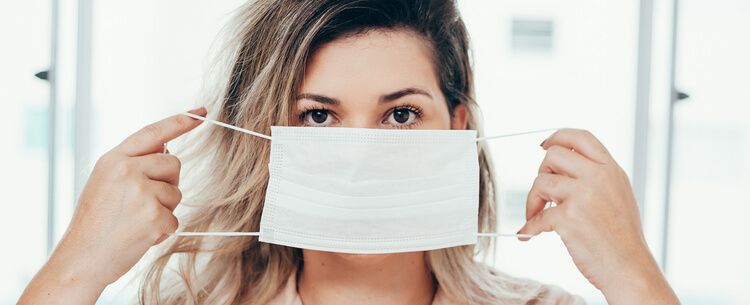Preventing & Treating Maskne: Acne Caused By COVID-19 Mask Wearing

Wearing a mask is among the most important things we can do to prevent the spread of COVID-19, and the proper use of a mask is required in many states. Wearing a mask for extended periods of time however, presents a new challenge for those with acne prone skin. “Maskne” is the trending term that describes acne that results from long-term mask use. Fortunately, there are simple ways to both limit maskne and treat even its most severe forms.
What Causes Maskne?
Maskne is a form of acne that results from long term contact between your mask and your face. Wearing a mask traps sweat, moisture from your breath, and oil against your nose, mouth, chin and cheeks. This creates an ideal breeding ground for acne-causing bacteria. The effect can be worse in hot or humid conditions.
Trapped moisture is not the only problem. The fabric of your mask traps dirt and other debris at the edges of your mask where it makes contact with your face. Masks also prevent proper skin cell shedding, which further increases the likelihood of occlusions and pimples.
Even proper mask wearing can lead to repetitive rubbing or friction on your cheeks, the bridge of your nose, or behind your ears. Anywhere the mask touches your face, you’re susceptible to aggravated or inflamed skin. In cold or dry climates, this can cause chaffing which increases the likelihood of clogged pores.
How to Prevent Maskne
Maskne can prevented with a few simple changes to your daily mask-wearing routine:
Choose Cotton Masks
Choosing a reusable cotton mask not only saves the surgical masks for those who need them most, but is a comfortable and breathable option that’s good for your skin. Cotton provides a nice balance between a mask that’s protective and non-irritating.
Choose a Proper Fitting Mask
A mask that fits properly will be snug against your face to limit air flow around the bridge of your nose, above your cheeks or under your chin. You’re also far less likely to pull and adjust a proper fitting mask. Each time you move your mask, you risk irritating your skin and transferring more germs or dirt to your face.
Keep Your Mask Clean
If you’ve chosen a reusable mask, be sure to keep it clean. Wash your mask frequently with a fragrance-free laundry detergent and let it air dry. Make-up, moisturizer, oils and debris get trapped in the fibers of your mask. When your mask isn’t clean, these impurities get pressed against your face.
If you’re wearing a disposable mask, avoid overuse. Dispose of masks between uses, or as soon as they show signs of dirt or soiling.
Clean Your Skin Before and After Wearing Your Mask
Clean your skin before you put your mask on and again when your mask comes off at the end of the day. To avoid drying your skin with multiple daily washes, choose a gentle cleanser or one that’s marked for sensitive skin. Follow up with a light moisturizer, which keeps skin balanced and prevents over-production of oils.
When Possible, Take a Mask Break
Giving your skin safe periodic breaks from mask wearing can do wonders. Remove your mask when you’re outdoors and at least 6 feet away from others, or choose to take your work breaks alone in your car. Removing your mask for a 15-minute breather also gives you a chance to quickly cleanse your face with an acne-preventing wipe.
Treating Maskne
Unfortunately, maskne cannot be 100% prevented and acne-prone individuals may have to deal with near continual maskne. There are, however, there are several things you can do to improve treat maskne and improve the overall condition of your skin.
Properly Cleanse Your Face Regularly
Use gentle, non-drying products to cleanse your skin day and night. Skip cleansers that contain fragrance or oils, and avoid scrubbing your skin, which can cause irritation.
Avoid Drying Products
To fight peeling or dryness, avoid products containing topical retinoids or alpha hydroxy acids unless prescribed by your dermatologist. Skip the leave-on salicylic acid treatments until you have the opportunity for a mask-free day. If you do opt for using a product containing a drying ingredient, its best to apply them overnight and follow up with a gentle moisturizer.
Use a Good Lightweight Moisturizer
While trapped moisture can be a problem with extended mask use, hydration is still important. Hydrated skin is balanced skin, and less likely to become chaffed, or to over-produce oils.
Limit Makeup Use
Makeup underneath your mask leads to clogged pores and increased acne. Limit the makeup under your mask to light moisturizer or sunscreen and a hydrating lip balm. If you love wearing makeup, focus on your eyes instead.
Exfoliate (but not too much)
Use a gentle exfoliant to clear away dead skin cells and other particles that may clog pores. Exfoliating weekly is plenty. Any more and your skin may actually produce more oil and bacteria, not less.
Consider Spot Treatments for Acne
One benefit of mask wearing is that it can hide acne you already have. To treat acne underneath your mask, skip the make-up and consider a spot treatment instead. A small dot of a treatment cream on your pimple will go unnoticed underneath a mask.
See a Dermatologist if Maskne Breakouts are Severe or Persistent
Many Board Certified Dermatologists offer advanced in-office acne treatments like specialized chemical peels and laser treatments or prescription medication like Accutane. If you’re already seeing a dermatologist for your acne, you should continue with your recommended course of treatment. If mask wearing is leading to more severe acne or persistent breakouts that’s aren’t responding to at-home treatments, it may be time to visit a dermatologist for a more effective treatment plan.
Disclaimer: The contents of the Westlake Dermatology website, including text, graphics, and images, are for informational purposes only and are not intended to substitute for direct medical advice from your physician or other qualified professional.

Really informative post! I havent had any issues with acne since High School but my job has me wearing these darn masks for 8 hours a day. I now have some pimples around the jawline and on my upper lip. I’ll give some of these tips a try. Get back to doing the oxy pads haha